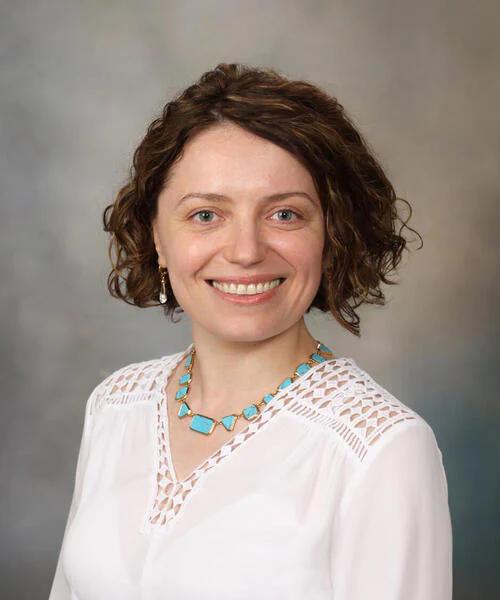Article
Study Details Impact of Curative Treatment on Hyperglycemia in Cushing Syndrome
Author(s):
A retrospective analysis of data from more than 170 patients with Cushing syndrome and hyperglycemia provides insight into the effects of curative treatment on hyperglycemia among these patients.
Irina Bancos, MD

An analysis of retrospective data from a 20-year period details the impact of curative treatment on hyperglycemia among patients with Cushing syndrome.
Led by a team of investigators from the Mayo Clinic in Rochester, MN, the study examined a cohort of 174 adult patients with Cushing Syndrome and determined 2-in-3 patients with hyperglycemia experienced resolution or improvement of hyperglycemia after a curative procedure.
“This is the first study to analyze the quantitative changes based on the time from the curative surgery, to assess the changes in the intensity of hyperglycemia therapy and identify predictors for hyperglycemia improvement,” wrote investigators.
A team led by Irina Bancos, MD, endocrinologist at the Mayo Clinic Rochester, designed the current study with an interest in examining the impact of curative procedures on hyperglycemia and its management in patients with Cushing syndrome from electronic medical record data of patients treated at a referral center from 2000-2019. The primary purpose of the study was to assess the impact of curative procedures on extent of hyperglycemia and the secondary aim was to investigators how baseline factors might influence improvement of hyperglycemia at follow-up.
For inclusion in the analysis, patients needed to be at least 18 years of age, diagnosed with Cushing syndrome, and have hyperglycemia treated with a curative procedure from January 1, 2000-November 1, 2019. For the purpose of analysis, Cushing syndrome was diagnosed based on clinical evaluation by an endocrinologist and diagnosed according to the most recent guidelines. Hyperglycemia was defined according to American Diabetes Association guidelines.
The primary outcome of interest for the study was the resolution of hyperglycemia following resolution of Cushing syndrome. For the purpose of analysis, resolution was defined as absence of hyperglycemia without the need for antihyperglycemic therapy. Secondary outcomes of interest included changes in HbA1c, and the intensity of hyperglycemia management.
Overall, 174 patients were identified for inclusion in the study. This cohort had a median age of diagnosis of 51 (range, 16-82) years and 73% (n=127) were women. When assessing subtype of Cushing syndrome, the most common form was pituitary Cushing syndrome (60.9%), followed by ectopic (14.4%), and adrenal (24.7%). The median baseline HbA1c was 6.9% (range, 4.9-13.1), 24% of patients were not on any therapy for hyperglycemia, 52% were on oral medications, and 37% were on insulin (mean daily units, 58; range, 10-360).
When assessing differences between subtypes, results indicated those with pituitary Cushing syndrome were younger at the time of surgery (P=.0009), and included more women (P=.0023), and reported a longer duration of symptoms prior to diagnosis. Investigators noted patients with pituitary Cushing syndrome also had the highest clinical severity score (P <.0001), but patients with ectopic Cushing syndrome had the highest biochemical severity score (P <.0001).
Following Cushing syndrome remission and at the end of follow-up, which occurred at a median of 10.5 months, 21% of patients demonstrated resolution of hyperglycemia, 47% demonstrated improvement, and 32% had no change or worsening hyperglycemia. When assessing secondary end points, results indicate HbA1c decreased by 0.84% (P <.0001) and daily insulin dose decreased by a mean of 30 units (P <.0001). Further analysis indicated hypercortisolism severity score (severe vs moderate/mild: OR, 2.4; 95% CI, 1.1-4.9) and Cushing syndrome subtype (nonadrenal vs adrenal: OR, 2.9; 95% CI, 1.3-6.4) were associated with hyperglycemia improvement, but not type of hyperglycemia (diabetes vs prediabetes: OR, 2,1; 95% CI, 0.9-4.9) at the end of follow-up.
“We demonstrated that almost 70% of patients with CS demonstrate either resolution or improvement in hyperglycemia following CS remission. As a group, patients demonstrate a decrease in HbA1c, and can be treated with less insulin and fewer non-insulin agents. Patients with more severe hyperglycemia, ACTH-dependent CS, and more severe CS are more likely to improve after surgery,” added investigators.
This study, “The impact of curative treatment on hyperglycemia in patients with Cushing syndrome,” was published in The Journal of the Endocrine Society.




